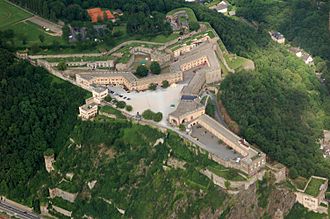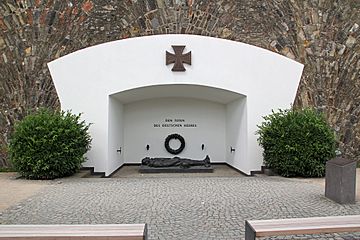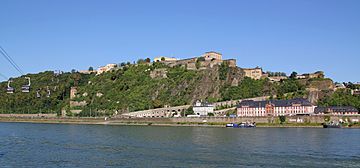Ehrenbreitstein Fortress facts for kids
Quick facts for kids Ehrenbreitstein Fortress |
|
|---|---|
|
Festung Ehrenbreitstein
|
|

Aerial view
|
|
| General information | |
| Type | Fortress |
| Town or city | Koblenz |
| Country | Germany |
| Coordinates | 50°21′54″N 7°36′54″E / 50.365°N 7.615°E |
| UNESCO World Heritage Site | |
| Part of | Upper Middle Rhine Valley |
| Criteria | Cultural: (ii)(iv)(v) |
| Inscription | 2002 (26th Session) |
Ehrenbreitstein Fortress (which means "Fortress Ehrenbreitstein" in German) is a huge fortress in Germany. It stands on the east bank of the Rhine River, where it meets the Moselle River. The fortress looks down over the city of Koblenz.
This fortress was built by Prussia between 1817 and 1828. It replaced an older fortress that the French had destroyed in 1801. Ehrenbreitstein was a very important part of a large defense system called Festung Koblenz. Its job was to protect the middle Rhine region, an area that French troops had often invaded before. Even though it was built to be strong, the Prussian fortress was never actually attacked.
Since 2002, Ehrenbreitstein Fortress has been part of the UNESCO World Heritage Site called the Upper Middle Rhine Valley. This means it's recognized as a very special place in the world.
Contents
Where is Ehrenbreitstein Fortress?
Ehrenbreitstein Fortress is located on the eastern side of the Rhine River. It is in the city of Koblenz, in the German state of Rhineland-Palatinate. The fortress sits high on a hill that shares its name. From the top, it offers amazing views of where the Mosel and Rhine rivers meet. The peak of the hill is 118 meters (about 387 feet) above the Rhine. It is the most northern point of the UNESCO World Heritage Site Upper Middle Rhine Valley.
History of the Fortress

Early Buildings on the Hill
The hill where Ehrenbreitstein Fortress now stands has been used by people for a very long time. People first lived there about 6,000 years ago. Fortifications, which are like early forts, were built there around 900 BC. Later, from the 3rd to 5th centuries AD, the Romans built a fort on the hill. More settlements appeared in the 8th and 9th centuries.
Around the year 1000, a nobleman named Ehrenbert built a castle on the hill. This castle was first called "Burg Ehrenbertstein," which later became Burg Ehrenbreitstein.
The castle was first officially mentioned in a document in 1139. It belonged to the Archbishop of Trier. Archbishops expanded the castle over the years, making it bigger and stronger. For example, Archbishop Hillin made it larger between 1152 and 1169.
From Castle to Fortress
In the 1500s, people started to change the castle into a fortress. This was because new weapons like cannons were being used. The fortress needed to be strong enough to defend against these powerful new guns. One of the first cannons there was a huge 9-ton gun called the Greif cannon.
The fortress was improved even more over time. In 1632, French soldiers took it over, and in 1637, Imperial troops occupied it during the Thirty Years' War.
Ehrenbreitstein was very important for protecting a valuable religious item called the Holy Tunic from 1657 to 1794. The Archbishops used the fortress's strong position to negotiate with different powerful groups.
In 1688, the fortress successfully defended itself against a siege by King Louis XIV of France. A siege is when an army surrounds a place to try and capture it. Around 1730, new defenses were added, making the fortress even stronger. France did manage to capture it in 1759, but they only held it for three years.
However, in 1794, French revolutionary troops captured Koblenz. They tried to besiege Ehrenbreitstein three times without success. But a very long siege, lasting a whole year from 1798, caused the defenders to run out of food. They finally gave up the fortress to French troops in 1799.
Later, the French had to leave the area. To make sure their enemies couldn't use the strong fortress, they blew up Ehrenbreitstein in 1801.
The Fortress We See Today
After a big meeting called the Congress of Vienna in 1815, the Rhineland area became part of Prussia. Prussia decided it was very important to build strong defenses around Koblenz. This was because it was close to France and was a key crossing point for rivers and roads.
So, the Prussians built a huge system of fortifications around Koblenz, known as Festung Koblenz ("Fortress Koblenz"). Ehrenbreitstein Fortress was a major part of this system. People said that Fortress Koblenz was the largest military fortress in Europe, except for Gibraltar. Ehrenbreitstein itself could be defended by up to 1,200 soldiers.
France even paid 15 million francs to help build the new fortress. Construction of the current fortress took place from 1817 to 1828. It was ready for use by 1834.
Even though it was built to be very strong, the fortress was never attacked during its active service. After World War I, it was almost taken apart, but it was saved because people recognized its historical and artistic importance. An American General, Henry Tureman Allen, helped prevent its destruction in 1922.
After 1919, the US Army used the fortress as their headquarters. In 1923, the US Army left, and the French Army occupied Ehrenbreitstein.
During World War II, the fortress was used to keep important archives and cultural objects safe. It also had three anti-aircraft guns from 1943 to 1945.
After World War II, the French Army used the fortress again. In 1947, it was given to the state of Rhineland-Palatinate. From 1946 to 1950, it was used as a camp for refugees. Then, it became housing for people during a time when there weren't enough homes.
In 1952, a youth hostel opened there. A museum followed in 1956. In 1972, a memorial for German soldiers was opened. In 2011, Ehrenbreitstein Fortress was a main part of the Bundesgartenschau (National Garden Show) in Koblenz. This happened after a big restoration project from 2007 to 2011.
Ehrenbreitstein Fortress Today
Today, Ehrenbreitstein Fortress is a popular place for visitors. You can reach it from Koblenz by a cable car that goes over the Rhine River. There's also an inclined lift at the bottom of the hill.
The fortress is home to several museums. These include the Haus der Fotografie (House of Photography), Haus der Archäologie (House of Archaeology), and the Landesmuseum Koblenz (which has temporary exhibitions). There's also a Haus des Genusses, which celebrates local wine and offers a special dining experience.
Permanent exhibitions inside the fortress tell the story of Ehrenbreitstein's 5,000-year history. You can also find places to eat and drink. The Koblenz youth hostel, which has 157 beds, is still part of the fortress.
Ehrenbreitstein is also a great place for cultural events. It hosts open-air concerts and plays, making it a lively spot for entertainment.
World Heritage Site Status
In 2002, the Upper Middle Rhine Valley was named a UNESCO World Heritage Site. This means it's a place of special cultural or natural importance to the world. Ehrenbreitstein Fortress is the most northern point of this famous World Heritage Site.
See also
 In Spanish: Fortaleza de Ehrenbreitstein para niños
In Spanish: Fortaleza de Ehrenbreitstein para niños
- List of forts
- Prussian semaphore system





